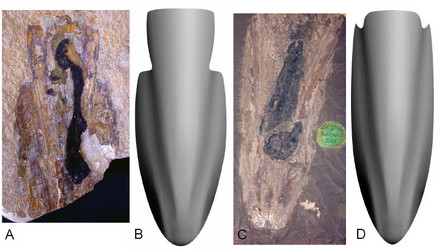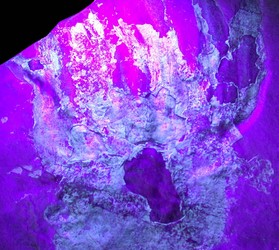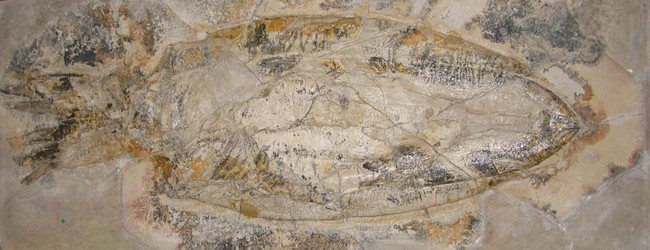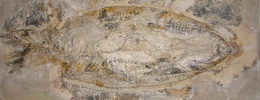Loligosepiina
Dirk Fuchs
- Loligosepiidae Regteren Altena, 1949

- Geopeltididae Regteren Altena, 1949

- Leptotheuthididae Naef, 1921

- Mastigophoridae Engeser & Reitner, 1985

- Necroteuthididae Kretzoi, 1942
 (incertae sedis)
(incertae sedis)
Introduction
Loligosepiina is a Jurassic-Cretaceous group of coleoids with a well-known gladius that has much in common with living Vampyroteuthis. According to Fuchs (2006) and Fuchs & Weis (2008), the Loligosepiina contains four families (Loligosepiidae, Geopeltididae, Leptotheuthididae, Mastigophoridae). Particularly, the gladius of the early Jurassic Geopeltididae remarkably resembles the Vampyroteuthis gladius in having a cup-shaped conus, a triangular median field, anteriorly extended hyperbolar zones and lateral fields that occupy c. 70% of the median field length.


Figure: Loligosepiid gladii. A) Parabelopeltis flexuosa (Toarcian, UK), B) gladius reconstruction of Parabelopeltis flexuosa, C) Loligosepia aalensis (Toarcian, Germany), C) gladius reconstruction of Loligosepia aalensis. © Dirk Fuchs
From the late Jurassic Leptotheuthis gigas, we know numerous arm crowns consisting of eight thick arms. Additionally, Bandel & Leich (1986) figured circular suckers, cirri and an arm web.


Figure: Head and arm crown of Leptotheuthis gigas (Tithonian, Solnhofen). © Dirk Fuchs
The Loligosepiina is regarded as an early stem-group of the Vampyromorpha that might have given rise to the Vampyroteuthididae.
Characteristics
- Gladius
- Conus ventrally reduced (cup-shaped).
- Median field broad and triangular (anterior extremity more or less straight).
- Hyperbolar zone developed as notches, hyperbolar zone length more than the half median field length.
- Lateral fields almost as long as the hyperbolar zone
Classification
- Loligosepiidae† Regteren Altena, 1949
- Loligosepia Quenstedt, 1839 (Sinemurian – Toarcian)
- Loligosepia aalensis (Schübler in Zieten, 1830-33)****
- Loligosepia bucklandi (Voltz, 1840)***
- Jeletzkyteuthis Doyle, 1990 (Toarcian)
- Jeletzkyteuthis coriaceus (Quenstedt, 1845-49)***
- Geopeltididae† Regteren Altena, 1949
- Geopeltis Regteren Altena, 1949 (Toarcian)
- Geopeltis simplex (Voltz, 1840)****
- Parabelopeltis Naef, 1921 (Toarcian)
- Parabelopeltis flexuosa (Münster, 1843)**
- Leptotheuthididae† Naef, 1921
- Leptotheuthis Meyer, 1834 (Tithonian – Aptian)
- Leptotheuthis gigas Meyer, 1834****
- Leptotheuthis stuehmeri (Engeser & Reitner, 1985)
- Mastigophoridae† Engeser & Reitner, 1985
- Mastigophora Owen, 1856 (Callovian)
- Mastigophora brevipinnis Owen, 1856****
- Doryanthes Muenster, 1846 (Tithonian)
- Doryanthes munsterii D´Orbigny, 1845**
- Bavaripeltis Engeser & Keupp, 1997 (Tithonian)
- Bavaripeltis bavarica Engeser & Keupp, 1997*
- (?) Necroteuthididae† Kretzoi, 1942 (?Oligocene)
- Necroteuthis hungarica Kretzoi, 1942*
Problematic Vampyromorpha:
- “Loligosepia dusslingensis“ Reitner & Engeser, 1981*
- Vampyronassa rhodanica Fischer, 2000**
- Gramadella piveteau Fischer & Riou, 1982*
- Proteroctopus ribeti Fischer & Riou, 1982*
- Nanaimoteuthis jeletzki Tanabe et al. 2008*
(*only 1 specimen known; ** 2-5 specimens; *** 5-10 specimens; **** > 10 specimens)
References
Bandel, K. & Leich, H. 1986. Jurassic Vampyromorpha (dibranchiate cephalopods). Neues Jahrbuch für Geologie und Paläontologie, Monatshefte 1986(3): 129-148.
Fuchs, D. 2006a. Fossil erhaltungsfähige Merkmalskomplexe der Coleoidea (Cephalopoda) und ihre phylogenetische Bedeutung. Berliner Paläobiologische Abhandlungen 8: 1-115.
Fuchs, D. 2006b. Re-description of Doryanthes munsterii (D´Orbigny, 1845), a poorly known vampyropod coleoid (Cephalopoda) from the Late Jurassic Solnhofen Plattenkalks. Archaeopteryx 24: 79-88.
Fuchs, D. & Weis, R. 2008. Taxonomy, morphology and phylogeny of Lower Jurassic loligosepiid coleoids (Cephalopoda). Neues Jahrbuch für Geologie und Paläontologie, Abhandlungen 249(1): 93-112.
Title Illustrations

Leptotheuthis gigas from the Tithonian (late Jurassic) of Solnhofen (germany). Body lengths of 120cm are very common.
| Copyright |
© Dirk Fuchs

|
|---|
About This Page
Dirk Fuchs

Hokkaido University
Correspondence regarding this page should be directed to Dirk Fuchs at
Page copyright © 2015 Dirk Fuchs
 Page: Tree of Life
Loligosepiina.
Authored by
Dirk Fuchs.
The TEXT of this page is licensed under the
Creative Commons Attribution-NonCommercial License - Version 3.0. Note that images and other media
featured on this page are each governed by their own license, and they may or may not be available
for reuse. Click on an image or a media link to access the media data window, which provides the
relevant licensing information. For the general terms and conditions of ToL material reuse and
redistribution, please see the Tree of Life Copyright
Policies.
Page: Tree of Life
Loligosepiina.
Authored by
Dirk Fuchs.
The TEXT of this page is licensed under the
Creative Commons Attribution-NonCommercial License - Version 3.0. Note that images and other media
featured on this page are each governed by their own license, and they may or may not be available
for reuse. Click on an image or a media link to access the media data window, which provides the
relevant licensing information. For the general terms and conditions of ToL material reuse and
redistribution, please see the Tree of Life Copyright
Policies.
- First online 03 May 2010
- Content changed 03 May 2010
Citing this page:
Fuchs, Dirk. 2010. Loligosepiina. Version 03 May 2010 (under construction). http://tolweb.org/Loligosepiina/140240/2010.05.03 in The Tree of Life Web Project, http://tolweb.org/








 Go to quick links
Go to quick search
Go to navigation for this section of the ToL site
Go to detailed links for the ToL site
Go to quick links
Go to quick search
Go to navigation for this section of the ToL site
Go to detailed links for the ToL site